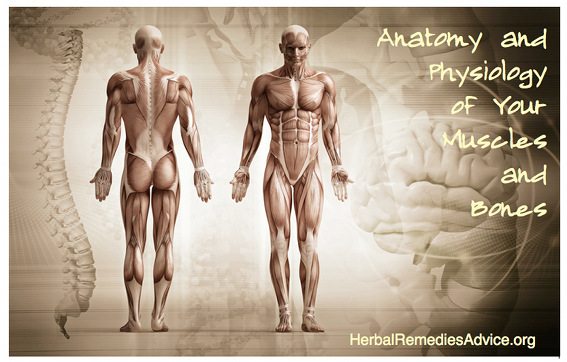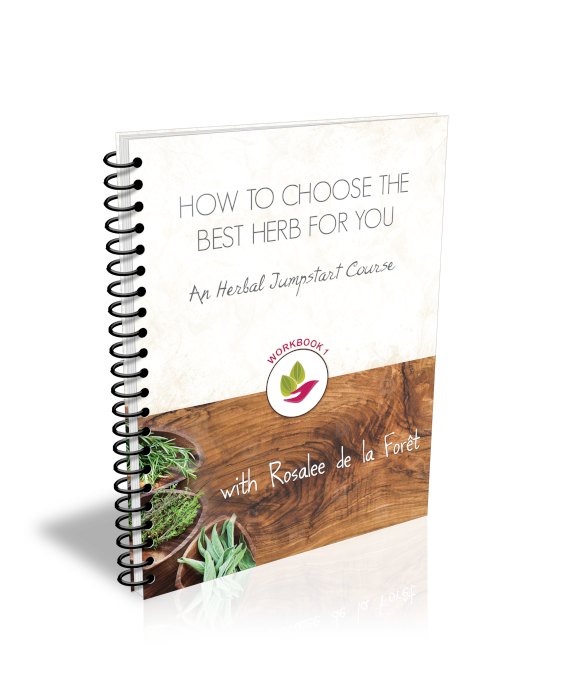Get weekly tips, recipes, and my Herbal Jumpstart e-course! Sign up for free today.

Human Musculoskeletal System
Share this! |
|
The human musculoskeletal system is made up of bones, muscles, and various connective tissues like fascia, tendons, ligaments, and cartilage. The two major functions of the musculoskeletal system is to provide movement and to protect vital organs.
This article looks at the human anatomy and musculoskeletal physiology. See this article for 7 Tips for a healthy musculoskeletal system.
Skeletal System (Bones)
The skeletal system is made up of the axial skeleton and the appendicular skeleton. The axial skeleton includes the skull, vertebrae, and rib cage. The appendicular skeleton comprises the upper and lower extremities, including the shoulder girdle through the fingers and the pelvis through the toes.
There are several types of bone tissues in the skeletal system:
- Compact bone tissue is a dense tissue that forms the outside layer of all bones and the majority of long bones. (The different shapes of bones are discussed below.)
- Spongy bone tissue is not as dense as compact bone tissue and provides the space where marrow is formed. Short, flat and irregularly shaped bones are mostly made up of spongy bone tissue.
We are born with as many as 350 bones in our body. Over the next few years these bones will fuse together so that the average adult has about 208 bones in their skeletal system. Bones have a variety of physiological functions that extend beyond the typical understanding of support.
According to the textbook Principles of Anatomy and Physiology, bones have the following 6 functions:
- Support – bones provide attachments for muscles, giving us our framework
- Protection – bones protect many of our vital organs such as our brain, spinal cord, heart and lungs
- Movement – as muscles pull on various bones, movement is achieved through our joints
- Mineral homeostasis – bones store calcium, phosphorous, and other minerals which are released when needed
- Site of blood cell production – red marrow is a connective tissue that lives in the bones and produces blood cells
- Storage of energy – yellow marrow is stored in the bones and is an important energy source made up of adipose (fat) tissue and other blood cells
Bones are formed in the womb and then are constantly remodeled during our entire lives. This remodeling is achieved quite quickly in some areas and much more slowly in other areas. For example, the bottom of the thigh bone (distal femur) is replaced every four months.
Minerals and vitamins are both needed for optimal bone remodeling. Important minerals include calcium, phosphorous, manganese and magnesium.
Muscular System (Muscles)
There are around 640 muscles in our body. They provide three main functions:
Movement
Our muscles are powered both by the nervous system and various hormones. They create virtually all movement in the body whether it’s your heart circulating the blood, your nose sniffing the air, your food being moved along in the digestive process or your arms encircling a loved one.
Posture and organ control
There are various postural muscles that, when awake, maintain sustained contractions to allow us to stand in gravity like keeping our head up for example. Our organs, such as the bladder, also maintain sustained contractions to temporarily hold their contents.
Keeping us warm
When skeletal muscles contract or work they generate heat. Muscle contractions are responsible for up to 85% of our heat. This is why when we are cold the hypothalamus initiates muscles in the body to shiver – this can raise our body temperature quickly and effectively.
Muscle Tissue Types
There are three types of muscle tissue:
Skeletal Muscle Tissue
Skeletal muscle tissue is aptly named because it is attached to the bones. Its movements across the joints create motion in the body. Skeletal muscle tissue is referred to as voluntary muscles because you can consciously contract and relax it.
Cardiac Muscle Tissue
Most of the heart is made from cardiac muscle tissue. It has some of the same make-up of voluntary muscles, but is an involuntary tissue because it is not ordinarily under conscious control.
Smooth Muscle Tissue
Smooth muscle tissue is found in most abdominal organs and blood vessels, and it attaches to hair follicles in the skin. This tissue has a slightly different make-up than voluntary muscles (as seen under a microscope) and is involved in involuntary movement. (Some anti-spasmodic herbs have a special affinity for relaxing smooth muscle tissue, like wild yam.)
Connective Tissue
Connective tissue or fascia is a continuous, 3D web of collagenous material that extends from head to toe, from front to back, from interior to exterior. The connective tissue or fascia is grouped into two categories.
Superficial Fascia
Superficial fascia is found directly under our skin. It has four important functions:
- Helps to hold our heat in
- Stores water and fat
- Helps to limit damage against traumatic blows
- Provides a pathway for nerves and blood to enter and exit muscles, thus providing an important role in intercellular communication.
Deep Fascia
Deep fascia is found surrounding each of our muscles and in areas where we need more stability like our sacrum. Deep fascia is also found in the abdominal cavity and secures our organs in place. This fascia is oftentimes called visceral fascia.
Fascia used to be given very little credit for its importance. This is due, in part, to how poorly fascia withstands the chemicals used for cadaver dissections. By the time people were dissecting, the fascia was just a shriveled white stuff of seemingly little consequence. We now know that our connective tissue is a huge part of our physical support system. We often envision our bones as keeping us upright but, in fact, our bones would be nothing but a pile on the floor without our fascia to keep it all together. Fascia is also our second line of defense (after our skin) against external pathogens. It also creates the environment for our bodies to heal from injury.
A great visual to understanding fascia is thinking about an orange. If you peel the skin of an orange you see a lot of white stuff underneath. This can be thought of as our superficial fascia directly underneath the skin. Next, if you peel the oranges into slices you notice that there is white stuff separating and surrounding each slice. Again, this is like our deeper fascia that separates and supports each of our muscles.
Tendons
Tendons, like fascia, are made of collagen. One of their functions is to attach muscles to the bone. (Whereas ligaments attach bone to bone and fascia attaches muscles to muscles.) Tendons also have a lot of elasticity and by acting as a spring they allow for more fluid and efficient movement in the body.
Summary
The human musculoskeletal system provides movement, protection and energy for the body. Although we’ve looked at each piece of the system separately, it operates as a whole and is directly linked to the nervous system and the immune system. Back pain, knee pain and general musculoskeletal discomfort are some of people’s biggest health complaints. Learn how to keep the musculoskeletal system healthy with this article.

Rosalee is an herbalist and author of the bestselling book Alchemy of Herbs: Transform Everyday Ingredients Into Foods & Remedies That Healand co-author of the bestselling book Wild Remedies: How to Forage Healing Foods and Craft Your Own Herbal Medicine. She's a registered herbalist with the American Herbalist Guild and has taught thousands of students through her online courses. Read about how Rosalee went from having a terminal illness to being a bestselling author in her full story here.

